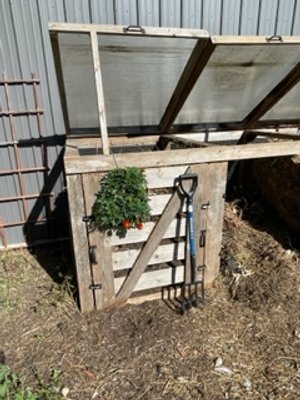…is AMAZING ( or should I say a-maizing )! The corn at WHF is beginning to tassel. The tassel represents the male flower. When it emerges it produces spikelets which then grow anthers which release millions (2-5 million!) of pollen grains. One of the grains must fall on a silk down below. Each silk on an ear of corn is a potential kernel, but only if it's fertilized. Now you know why some ears of corn have empty spaces where kernels should be. The first time Conrad and I planted corn, we planted a 50 foot row...and got nothing. I soon learned corn has to be planted in blocks so those millions of pollen grains land on some silks. Something very curious...silks are receptive to pollen grains anywhere along the silk. Wow...way more questions than answers!
Snakes and scapes...
It’s that time when the garlic plants send up their beautiful, graceful scapes. By cutting off the scape and not allowing the garlic to flower, more energy is sent to the bulb, resulting in bigger garlic! And I am left with these deliciously fragrant ends that are perfect for grilling, stir-frying or making pesto! But I wasn’t prepared for the friend I found in the path. Almost kicked it out of the way, thinking it was a fallen branch. Thankfully, I did not. It seems I have nothing to fear, as it appears to be a milk snake, non-venomous, and really not eager to cause a fuss. In fact, I should be grateful to see him, as he is keeping rodents out of the garden. I really should rethink my choice of footwear! (Who would have ever thought that I’d have a relationship with bees and snakes!)
Who knew....
…being a beekeeper could be so much fun! Observing the colony is fascinating…but, as always, more questions than answers!
The bees have arrived
And they have been carefully placed in our hive, along with their queen! First real inspection will be this weekend, giving them a few days to get settled! More to come…..
Morchella....
…or true morels have been plentiful this year thanks to several drenching rains. I remember last year’s disappointment at not being able to find any! This year we are experimenting with dehydrating them so they will be available throughout the summer.
I buried a dear friend this week....
Poppy, one of our original chickens! Feisty, strong-willed, and fiercely independent, she kept the other girls in line, and actually taught them how to be a flock. She taught me how I needed to care for this flock…with friendship, kindness and patience. She had a remarkable sense of humor, too, and reminded all of us of the importance of being able to laugh at ourselves. I knew she was declining several months ago, when she allowed Bertha to take over as mother hen. Her posture had changed. and her silhouette resembled that of a little old lady. The rest of the girls sensed it too, and seemed to understand that Poppy should be accorded special privileges. Each night they made a special place for Poppy on the roost, securely tucked in the middle, between all the rest. I’ll miss you, Poppy, and I hope you know how grateful we all are for having you in our lives!
First full day of spring....
and this hungry bee is scrounging for food! I think the recent unseasonable weather has encouraged bees to leave their hives prematurely. There is hardly any pollen available to them! He was fortunate to find some in the crocus plants that have just begun to bloom. But it will be many weeks before real food is available for them. We are looking forward to becoming bee keepers this May. We have painted and sited the hive, taken the classes, and ordered the bees. But seeing this little one frantically looking for food gives me pause…I hope we are up to the challenge!
Daylight savings time....
doesn’t seem to affect the chickens! They know spring is on its way…so they are ramping up production!
It's all about the soil!
Spent a wonderful day with the Master Gardeners of Green County. They were hosting their yearly symposium and had a great line-up of dynamic speakers. One speaker quoted Wendell Berry…”the soil is the great connector of lives, the source and destination of all. It is the healer and restorer and resurrector, by which disease passes into health, age into youth, death into life. Without proper care for it we can have no community, because without proper care for it we can have no life. This reminded me of a quote over 2000 years ago by Xenophon (400 B.C.) “to be a successful farmer one must first know the nature of the soil.
New Greenhouse Manager
I welcomed this little guy to the greenhouse last fall, but haven’t seen him all winter. I’ve been worried about PC2 (Prince Charming II) and then, while moving fig trees around, there he is! I think he’s a Cope’s Gray Treefrog (Hyla chrysoscelis). The original Prince Charming enjoyed the greenhouse accommodations for 6 years! Welcome to Walnut Hill Farm!
Nothing goes to waste!
We are busy cleaning out the beds in preparation for the planting of garlic and shallots at the end of this month. I have been finding all sorts of things…carrots that weren’t pulled, onions left behind, and way too much parsley (what was I thinking). Instead of carrying them off to the dump, we’ve been making vats of vegetable stock, and it’s been flying out the door as family and friends take some home for their freezers.
Black Gold!
Now is the time I appreciate all the compost that’s been “cooking” all year. It”s so rich in organic matter, you can see a marigold growing on the side of the bin. As we ready each of the beds for winter, we apply a generous amount of this “black gold,” then top with a layer of straw.
Can you guess what this is?
Kayaking, 7 new chicks, and beekeeping classes have kept me busy this summer. I hope I’m not neglecting the “farm!” But I have stumbled on to the most incredible invention and am exploring it for use in elementary schools. It’s called a Foldscope, a cardboard, folded origami-type microscope with 140x magnification, that fits in your pocket and costs a fraction of a science textbook. (Yes, I know…I have an origami kayak, too!) Every 5th grader should have one and I’d like to develop the science curriculum for the year that would center around it. Developed by a Standford professor to put in the hands of health care providers in third world villages….and so many other uses. So I have been having fun exploring the anatomy of a honeybee. This is a photo of the bee’s hindwing. You can clearly see the hamuli, or hook-shaped projections, that connect to the forewing while the bee is in flight. AMAZING! (A foldscope with accessories and training, costs $19.95)
Strawberries!
Strawberry season is in full swing at Walnut Hill Farm…and they’re served at breakfast, lunch and dinner!
Plentiful peas!
The peas have been beautiful this year…and the deer think so, too. Fortunately, we planted enough for everyone! These are Avalanche Snow Peas from High Mowing Seeds. @CalihanCooks is planning on using them tonight in Joshua McFadden’s Pasta alla Gricia with Slivered Snap Peas.
















